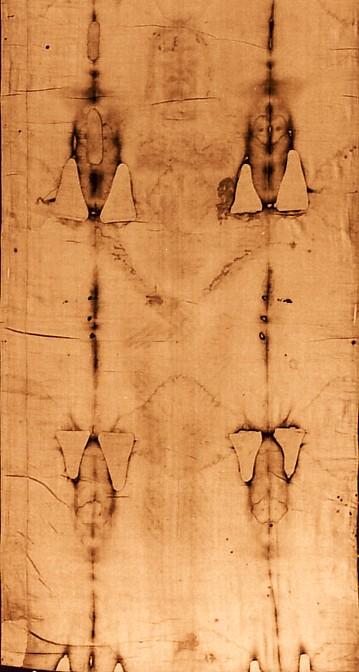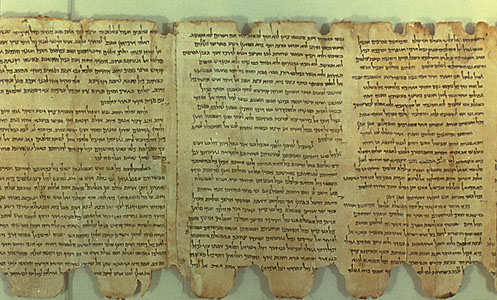Shroud Basics 101
The Shroud of Turin may be the greatest unsolved mystery of all time. Could this bloodstained sheet of linen be the burial cloth of Jesus of Nazareth? The implications are enormous.
The Shroud is 14 feet long and 3.5 feet wide and has been kept in Turin, Italy since 1578. It is made out of flax using manufacturing techniques available in the First Century. It bears the faint front and back images of a 5'10" man who appears to have died from crucifixion. Experts say it is consistent with Jewish burial practices of the time.

The single most important question is whether or not it COULD be authentic. Absolute scientific certainty is not possible. But the alternative is that it must be the deliberate work of an artist.
A team of 24 highly qualified scientists had direct access to the cloth for five days in 1978. They performed dozens of tests, took hundreds of particle samples and took thousands of photographs. It was an unprecedented opportunity. Never had any religious artifact been so thoroughly analyzed. Could it be authentic? The Shroud of Turin Research Project (STURP) announced their findings in 1981:
"There are no chemical or physical methods known which can account for the totality of the image, nor can any combination of physical, chemical, biological or medical circumstances explain the image adequately. Thus, the answer to the question of how the image was produced or what produced the image remains, now, as it has in the past, a mystery."
“We can conclude for now that the Shroud image is that of a real human form of a scourged, crucified man. It is not the product of an artist. The blood stains are composed of hemoglobin and also give a positive test for serum albumin.”
Take a good look at this 14 foot long cloth with the front and back image of a 5’10” bearded crucified man. High Resolution Image
Watch a short video clip of a lecture given by researcher Russ Breault about what the Shroud reveals.
A Further Introduction to the Shroud
A Quick Summary of Shroud Facts
Why is the Shroud Important?
Some would ask, "Why is the Shroud important?" The answer is related to its potential. After thousands of hours of hands-on scientific, medical and historical research, the image remains a mystery. Proving or disproving authenticity has remained elusive. If it was an obvious work of art, we would have known that by now. The findings of the STURP project leave open a clear possibility that the Shroud COULD be authentic. The implication is enormous. Far greater than even the Dead Sea Scrolls, the Shroud could be the world's most significant archaeological artifact yet hidden by controversy and confusion instead of dirt and debris. This profound possibility makes it worthy of continued research and investigation.
The Evidence for Authenticity:
There is no proof that the image on the Shroud is caused by the resurrection. However, the bloodstains are from actual wounds. The blood is determined to be human blood and was transferred to the cloth by direct contact with a corpse. The image remains inexplicable. The image is not the result of an artist as no artistic substances have been found on the cloth that could have been used to create the image. Further, no stains of putrefaction have been found.
The cloth appears to have wrapped a corpse that was brutally executed in a manner consistent with the narrative of the four Gospels of the New Testament. Post mortem blood flow shows the man was dead. The Shroud itself appears to be a genuine Jewish burial cloth consistent with first century Jewish guidelines established by Rabbi Gamaliel, of using a single plain linen shroud.
The evidence of flower images and pollen from Israel indicate the cloth originated in Israel and may have been used in an actual burial. The manufacture of the cloth is extremely ancient and significantly predates the Middle Ages. This is just the tip of the iceberg in terms of fascinating clues resulting from thousands of hours of investigation.
Evidence Against Authenticity:
The principle finding that challenges authenticity is carbon dating. The cloth was dated by three laboratories in 1988 and was determined to have a date range of 1260 to 1390. However, these findings were challenged from the very beginning due to the violation of the sampling protocol. In addition, they did not perform micro-chemical analysis to make sure the sample cut was fully representative of the entire cloth as required by the protocol. Even Harry Gove, the inventor of the AMS nuclear accelerator used to date the cloth called it a "shoddy enterprise".

The core concern is that using only one sample offered no back up in the event of contamination. The other concern is more serious and stems from the location of the sample, which was from the outside corner edge where the cloth had been held and handled hundreds of times over the centuries. The concern was not so much contamination, but rather that the corner in question may have been repaired by highly skilled French weavers. In 1996 it was determined by Dr. Alan Adler, using advanced spectroscopy, that the sample used for carbon dating was not chemically consistent with the rest of the cloth.
This finding led thermal chemist Ray Rogers to examine actual thread samples from the dating sample and compare them with other thread samples. Adler's work was confirmed-the samples are not the same. As published in the peer-reviewed journal, Thermo-Chimica Acta (January 2005), the sample cut for carbon dating was in fact completely different from the rest of the Shroud and must have been subject to a medieval repair. As a result of these new findings, the one main argument against authenticity has now been seriously challenged. Read more on carbon dating here.
Legitimate Subject for State Supported Schools:
The Shroud is a marvelous mystery worthy of study for all students. It is filled with controversy and intrigue. Simply because it has religious implications does not preclude it from being a legitimate and fascinating subject of academic study. Some public institutions may erroneously fear a violation of church and state separation. This, however, is not a credible concern.

It would be ludicrous to consider a discussion of the Dead Sea Scrolls, the greatest archaeological discovery of the 20th century, to be crossing the lines of separation. Historical and archaeological artifacts have been, and always will be, appropriate objects of study for students at secular schools.
The Shroud is an equally valid subject. It is a multi-faceted topic involving numerous streams of research including science, history, art, medicine, current events and religion. Each aspect offers a valid reason for study in a secular environment.

Shroud University • © 2014 • Shroud of Turin Education Project, Inc.
P.O. Box 3397, Peachtree City, GA 30269 • Office 678-817-7188
Contact Us • Home
